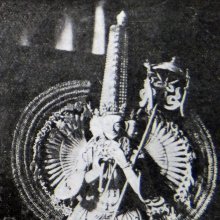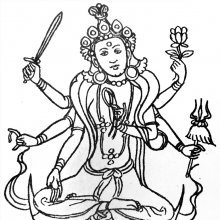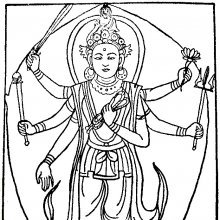Pratyangira, Pratyaṅgirā: 9 definitions
Introduction:
Pratyangira means something in Hinduism, Sanskrit. If you want to know the exact meaning, history, etymology or English translation of this term then check out the descriptions on this page. Add your comment or reference to a book if you want to contribute to this summary article.
Images (photo gallery)
In Hinduism
Shilpashastra (iconography)
Source: Sreenivasarao's blog: Saptamatrka (part 4) (shilpa)Pratyangira.—Narasimhi is sometimes identified with Pratyangira who is endowed with four arms and a face as terrible as that of a lion. Her head is that of a male lion and her body is that of a human-female. Her hair stands erect on her head. In her hands she holds a skull, trident, Damaru and the noose (nagapasa). She is seated on a lion and by her power destroys all enemies.
In Tantric worship, Pratyangira is shown with a dark complexion, ferocious in aspect, having a lion’s face with reddened eyes and riding a lion wearing black garments, she wears a garland of human skulls; her hair strands on end, and she holds a trident, a serpent in the form of a noose, a hand-drum and a skull in her four hands. She is also associated with Bhairava, as Atharvana-Bhadra-Kali.

Shilpashastra (शिल्पशास्त्र, śilpaśāstra) represents the ancient Indian science (shastra) of creative arts (shilpa) such as sculpture, iconography and painting. Closely related to Vastushastra (architecture), they often share the same literature.
Shaktism (Shakta philosophy)
Source: Google Books: ManthanabhairavatantramPratyaṅgirā (प्रत्यङ्गिरा) is a form of Kālī and identified with Goddess Tvaritā, according to the Kulakaulinīmata verse 3.310.—Tvaritā is also identified as Pratyaṅgirā, a form of Kālī.1 An indirect link with her and Kālī is also made in the Kālīkrama Tantra, the Kramasadbhāva, from which most of chapter fifteen of the Kulakaulinīmata is drawn. There Narasiṃha takes the place of Bhairava and Tvaritā of Kālī (as Kālasaṃkarṣiṇī), his consort. We are told that Viṣṇu can assume two forms. One is that of the fierce Narasiṃha. The other is like a child. His power is the goddess Tvaritā.

Shakta (शाक्त, śākta) or Shaktism (śāktism) represents a tradition of Hinduism where the Goddess (Devi) is revered and worshipped. Shakta literature includes a range of scriptures, including various Agamas and Tantras, although its roots may be traced back to the Vedas.
Languages of India and abroad
Sanskrit dictionary
Source: Cologne Digital Sanskrit Dictionaries: Shabda-Sagara Sanskrit-English DictionaryPratyaṅgirā (प्रत्यङ्गिरा).—f.
(-rā) A form of Durga, one of the goddesses of the Tantrikas.
Source: Cologne Digital Sanskrit Dictionaries: Aufrecht Catalogus Catalogorum1) Pratyaṅgirā (प्रत्यङ्गिरा) as mentioned in Aufrecht’s Catalogus Catalogorum:—[tantric] Rādh. 27. 43. Oudh. Xvii, 104.
2) Pratyaṅgirā (प्रत्यङ्गिरा):—[tantric] Gov. Or. Libr. Madras 53. Oudh. Xxi, 164.
Source: Cologne Digital Sanskrit Dictionaries: Monier-Williams Sanskrit-English Dictionary1) Pratyaṅgirā (प्रत्यङ्गिरा):—[=praty-aṅgirā] [from praty > prati] f. Acacia Sirissa, [Rasaratnākara]
2) [v.s. ...] a form of Durgā, one of the goddesses of the Tāntrikas, [Catalogue(s)]
Source: Cologne Digital Sanskrit Dictionaries: Yates Sanskrit-English DictionaryPratyaṅgirā (प्रत्यङ्गिरा):—(rā) 1. f. Durgā.
Source: DDSA: Paia-sadda-mahannavo; a comprehensive Prakrit Hindi dictionary (S)Pratyaṅgirā (प्रत्यङ्गिरा) in the Sanskrit language is related to the Prakrit word: Paccaṃgirā.
[Sanskrit to German]
Sanskrit, also spelled संस्कृतम् (saṃskṛtam), is an ancient language of India commonly seen as the grandmother of the Indo-European language family (even English!). Closely allied with Prakrit and Pali, Sanskrit is more exhaustive in both grammar and terms and has the most extensive collection of literature in the world, greatly surpassing its sister-languages Greek and Latin.
See also (Relevant definitions)
Partial matches: Praty, Angira, Ankira.
Starts with: Pratyangirakalpa, Pratyangiramalamantra, Pratyangiramantra, Pratyangiramantrariksamudaya, Pratyangirapancanga, Pratyangiraprayoga, Pratyangiras, Pratyangirasa, Pratyangirasahasranaman, Pratyangirasahasranamastotra, Pratyangirasayoga, Pratyangirasiddhamantroddhara, Pratyangirastotra, Pratyangirastotropasanadi, Pratyangirasukta, Pratyangiratattva, Pratyangiravidhi, Pratyangirayantravidhana.
Ends with: Mahapratyangira, Mantrashastrapratyangira, Viparitapratyangira.
Full-text (+1): Pratyangiraprayoga, Pratyangiratattva, Pratyangirapancanga, Pratyangirastotra, Pratyangirakalpa, Pratyangiramantra, Pratyangirasukta, Pratyangirastotropasanadi, Pratyangirasiddhamantroddhara, Pratyangirasahasranaman, Pratyangiramantrariksamudaya, Pratyangirasahasranamastotra, Pratingira, Mantrashastrapratyangira, Paccamgira, Viparitapratyangira, Sharabhesha, Purvamnaya, Kolhapur, Uttaramnaya.
Relevant text
Search found 8 books and stories containing Pratyangira, Pratyaṅgirā, Praty-angira, Praty-aṅgirā; (plurals include: Pratyangiras, Pratyaṅgirās, angiras, aṅgirās). You can also click to the full overview containing English textual excerpts. Below are direct links for the most relevant articles:
The Indian Buddhist Iconography (by Benoytosh Bhattachacharyya)
Varahi Tantra (English Study) (by Roberta Pamio)
Chapter 15 - The worship of Siddhilakṣmī < [Summary of the Vārāhī Tantra]
The Agni Purana (by N. Gangadharan)
The Garuda Purana (by Manmatha Nath Dutt)
Chapter XIX - The Garudi Vidya which is the cure for all kinds of snake-bite < [Agastya Samhita]
The Practice Manual of Noble Tārā Kurukullā (by Dharmachakra Translation Committee)
Chaitanya's Life and Teachings (by Krishna-das Kaviraj)


